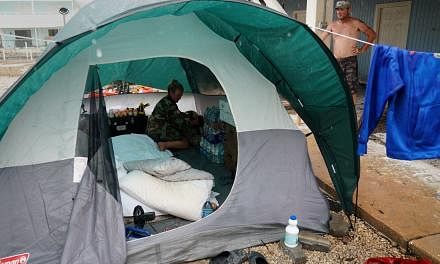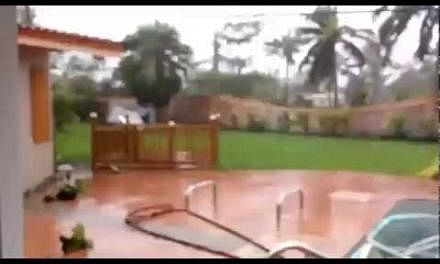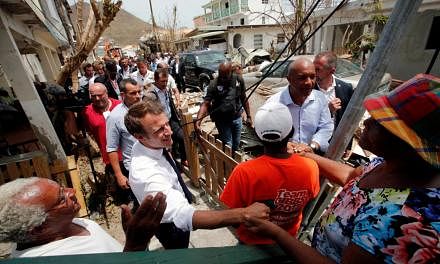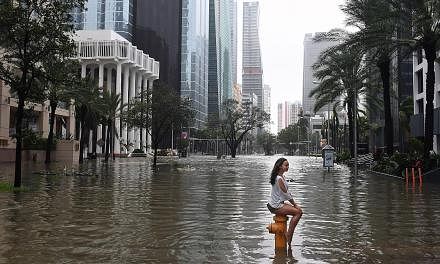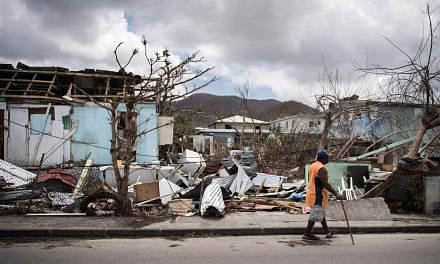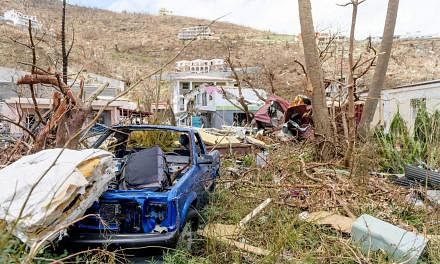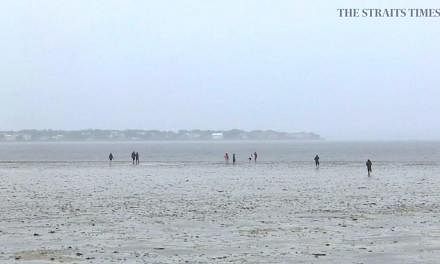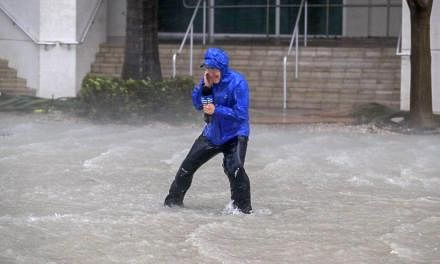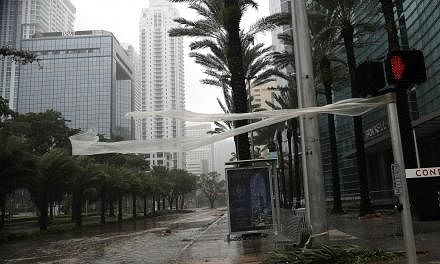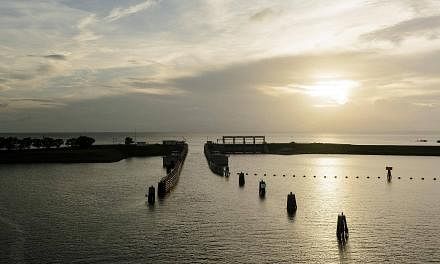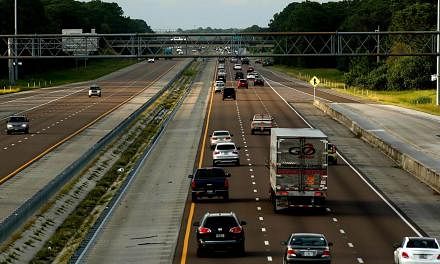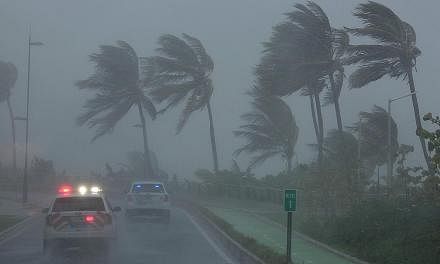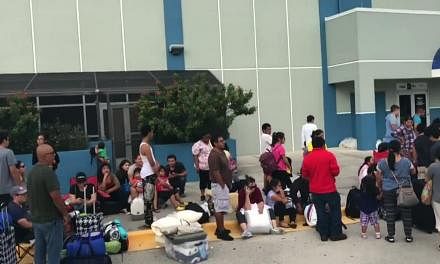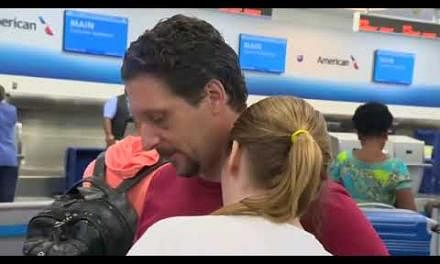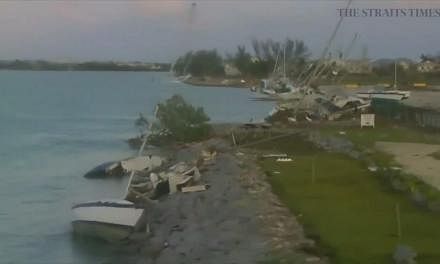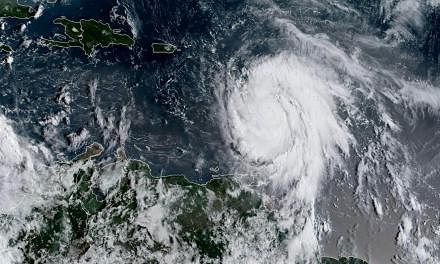MIAMI (AFP) - Hurricane Irma, which has toppled cranes, swallowed streets and left millions without power, was starting to weaken on Monday (Sept 11) while still pummelling parts of Florida on its destructive march north.
Irma was downgraded to a Category 1 hurricane early on Monday and forecasters expect it would become a tropical storm later in the morning, but warnings of hazardous storm surges persisted in several areas even after the worst of Irma's ferocity had passed.
Maximum sustained winds had decreased to 120.7km per hour as of 5am local time as Irma blazed its disastrous path through Florida, where more than six million people had been ordered to flee in one of the biggest evacuations in US history.
The massive storm's centre was forecast to move near the northwestern coast of Florida before crossing into the state of Georgia later into Monday.
The National Hurricane Centre cautioned that tornadoes remained possible in north-east Florida as well as south-east parts of Georgia and South Carolina into the evening.
Warnings of "life-threatening" storm surges remained in place in several areas of south and central Florida, including the heavily populated Tampa Bay region.
"As little as six inches of moving water can knock you down," tweeted the state's governor, Mr Rick Scott, following Irma's downgrade.
"Stay inside. Stay safe," he added. "The combination of a dangerous storm surge and the tide will cause normally dry areas near the coast to be flooded."
After wreaking a trail of death and destruction through the Caribbean, Irma killed three people when it struck the southern Florida Keys island chain as a powerful Category 4 storm on Sunday.
More than four million customers were without power throughout the state, according to Florida's Division of Emergency Management.
Florida Power and Light said it had "safely shut down" one of two nuclear reactors at its Turkey Point power plant.
Handfuls of holdout residents, having defied calls to evacuate, hunkered down as Irma tore over the Keys, ripping boats from their moorings, flattening palm trees and downing power lines across the island chain popular for fishing and scuba diving.
Hours later, one of the mightiest hurricanes ever to slam the state made a second landfall on Marco Island, near the beach resort of Naples.
"I am concerned about people that don't believe in the storm surge," said Virginia Defreeuw, 76, who had fled her mobile home in Naples to a shelter. "You need to be afraid of the storm surge! People are not listening."
While south-west Florida bore the deadly brunt of Irma's wrath on Sunday, the coastlines of Miami and the neighbouring island of Miami Beach were heavily inundated by storm surges as hurricane winds sent two giant construction cranes crashing down.
The sea swallowed the coastal walkway of glitzy Brickell Avenue in the centre of Miami, flooding the streets and leaving cars half-submerged.
"The wooden pier is basically gone," said Mr Steven Schlacknam, a 51-year-old visual artist watching from a 37th floor apartment.
President Donald Trump, who promised to travel to Florida "very soon", approved the state's request for emergency federal aid to help with temporary housing, home repairs, emergency work and hazard mitigation.
"Right now, we're worried about lives, not cost," Mr Trump said.
At least 30 deaths are already attributable to the storm. The US victims included a sheriff's deputy killed in a head-on collision early on Sunday as she drove home for supplies after working in a shelter all night.
Irma smacked the Keys 57 years to the day after Hurricane Donna hit the same area in 1960, destroying nearly 75 per cent of the island chain's buildings.
Irma also led to some uniquely Floridian responses, with a sheriff forced to warn residents not to shoot at the storm after an online prank promoting the idea went viral.
"To clarify, DO NOT shoot weapons @ #Irma," the office of the sheriff of Pasco County, on the state's west coast, tweeted hours before landfall.
In Miami, where emergency services were sheltering in place, a dispatcher talked a woman through delivering her own baby on Sunday morning, Assistant Fire Chief Eloy Garcia told the Miami Herald.
Before reaching the United States, Irma smashed through a string of Caribbean islands from tiny Barbuda on Wednesday, to the tropical paradises of Saint Barts and Saint Martin, the US Virgin Islands, Puerto Rico, the Dominican Republic, Haiti and the Turks and Caicos.
Terrified Cubans who rode out Irma in coastal towns - after it made landfall on Friday on the Camaguey archipelago as a maximum-strength Category 5 storm - reported "deafening" winds, uprooted trees and power lines, and rooftops blown off.
There were no immediate reports of casualties in Cuba, but it caused significant damage, and enormous waves lashed the Malecon, Havana's emblematic seafront, with seawaters penetrating deep into the capital.
Residents in the old colonial city were waist-deep in floodwaters after Irma cut power and forced the evacuation of more than a million people.
Businesses on both Florida coasts were shuttered while Miami airport was closed and not expected to reopen until Tuesday.
MacDill Air Force Base in Tampa, the military installation home to US Central Command, issued mandatory evacuation orders ahead of the storm's passage early on Monday, while the Kennedy Space Centre on the east coast was also closed.

